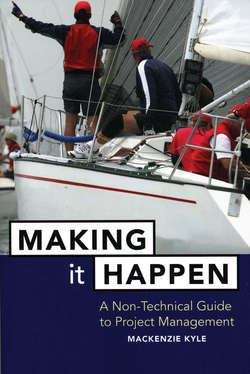Читать книгу Making It Happen - Kyle Mackenzie - Страница 4
На сайте Литреса книга снята с продажи.
Part One
Genesis
1
Sink or Swim
The Company
ОглавлениеThe meeting had not started out badly. “So what we have here,” Stu had been telling me, “is a major opportunity to complement our existing product line, and you know how they love that kind of thing at head office in Denver. Not only will it create new customers, but if our experience is anything like what they’ve seen in Europe, it will lead to more sales of our existing products further down the line.”
This was exciting news. Although I had spent the last 18 months in the Information Systems area, Hyler was a small organization and everyone knew the ground rules. Our company was just a stop-over for the up-and-coming movers and shakers at Mantec. Innovation leading to expanded sales was a sure ticket for promotion out of Hyler. But to put all of that in context, I should tell you a little bit about the organization.
Andrew Hyler started the company during the war to make life boats and life rafts for the U.S. Navy. He located his operation in Enderby, Oregon, just outside Portland. Like many war-time industrialists with a guaranteed demand and price, he was successful. When the war ended and new military contracts were not forthcoming, Andrew decided to go on making boats, but now they would be pleasure boats. Everyone called him crazy, especially since he lived way out in Oregon, where there were not a lot of people.
Old Andrew must have seen what was coming because he did very well for himself. After the war, just about all forms of recreation became popular and boating was no exception. Since Hyler was the only manufacturer on the West Coast, he had a definite competitive advantage. Not only did he build better boats than they made back East, he could sell them cheaper because his shipping costs were a fraction of the competition’s. He had such a grip on the market that none of the Eastern manufacturers even bothered to open up a West Coast plant. When aluminum boats became popular, Andrew was well positioned to scoop that market too.
By the time the sixties rolled around, Andrew Hyler was getting on and he no longer wanted the day-to-day hassles of running a business. In 1967 he sold the company to Mantec Corporation, a major conglomerate whose holdings included oil and gas fields, refineries, pulp mills, trucking companies, and vast amounts of real estate. The purchase of a boat plant was the final step in an elaborate plan that the Mantec executives had worked out. Hyler was to be a training ground for developing managers. “Trainees” could make their mistakes and learn at Hyler, where the stakes were small, before moving on to bigger and better things within the parent corporation. To this day, all of Mantec’s top executives, and the heads of most of its subsidiaries, have spent time at Hyler.
This means that managers who come through our company have high expectations placed on them, which is probably why Hyler has led the field in recreational boating on the West Coast for the last 25 years. The company now has sales approaching $40 million, and in addition to aluminum boats (which are a decreasing portion of our business), we make several models of windsurfers, sailboats, boat trailers, dinghies, and sails. Our last big product line expansion was into personal floatation devices. That was the brainchild of the former vice-president of Marketing, and it did so well that she is now president of one of Mantec’s huge box companies in Texas.
So what Stu was saying about this new product was bound to make a guy like Ralph Borsellino happy.
